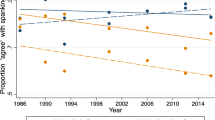Abstract
This study examined regional differences in college students experiences with corporal punishment. Students from two universities, one in the Northeast and one in the South, were surveyed about three aspects of spanking: their experiences receiving physical punishment, their assessments of their punishments, and their attitudes toward spanking. In general, Northeastern students were less likely than Southern students to have been hit and were hit less frequently. Further, Northeastern students were less likely than Southern students to feel that their spankings were justified, and less likely to favor spanking. Analyses of covariance for selected dependent variables controlling for religion, parents' education, and gender revealed that the effect of region was more important for attitudes than for behaviors. Implications of the findings for parents, children, and family professionals are discussed.
Similar content being viewed by others
References
Baron, L., and Straus, M.A. (1988). Cultural and economic sources of homicide in the United States.Sociological Quart. 29: 371–390.
Bryan, J. W., and Freed, F. W. (1982). Corporal punishment: Normative data and sociological and psychological correlates in a community college population.J. Youth Adolescence 11(2): 77–87.
Deley, W. W. (1988). Physical punishment of children: Sweden and the U.S.A.J. Comp. Fam. Studies 19(3): 419–431.
Flynn, C. P. (1994). Regional differences in attitudes toward corporal punishment.J. Marr. Fam. 56: 314–324.
Gastil, R. D. (1971). Homicide and a regional culture of violence.Am. Sociological Rev. 36: 412–427.
Giles-Sims, J., Straus, M. A., and Sugarman, D. B. (1995). Child, maternal, and family characteristics associated with spanking.Fam. Relat. 44: 170–176.
Greven, P. (1990).Spare the Child: The Religious Roots of Punishment and the Psychological Impact of Physical Abuse, Alfred A. Knopf, New York.
Graziano, A. M., and Namaste, K. A. (1990). Parental use of physical force in child discipline: A survey of 679 college students.J. Interpers. Viol. 5(4): 449–463.
Hurlbert, J. S. (1989). The southern region: A test of the hypothesis of southern distinctiveness.Sociological Quart. 30: 245–266.
Hyman, I. A. (1990).Reading Writing and the Hickory Stick, Lexington Books, Lexington, MA.
Larzelere, R. E. (1986). Moderate spanking: Model or deterrent of children's aggression in the family?J. Fam. Viol. 1: 27–36.
Reed, J. S. (1971). To live-and die—in Dixie: A contribution to the study of southern violence.Polit. Sci. Quart. 86: 429–443.
Straus, M. A. (1991). Discipline and deviance: Physical punishment of children and violence and other crime in adulthood.Social Prob. 38: 133–154.
Straus, M. A., and Donnelly, D. A. (1993). Corporal punishment of adolescents by American parents.Youth Soc. 24: 419–442.
Straus, M. A. and Gimpel, H. S. (1992). Corporal punishment by parents and economic achievement: A theoretical model and some preliminary empirical data. Paper presented at the 1992 meeting of the American Sociological Association. Family Research Laboratory, University of New Hampshire, Durham, NC.
Straus, M. A., and Lauer, S. (1992). Corporal punishment of children, substance abuse, and crime in relation to race, culture, and deterrence, Paper presented at the annual meeting of the American Society of Criminology, New Orleans, LA.
Wauchope, B., and Straus, M. A. (1990). Physical punishment and physical abuse of American children: Incidence rates by age, gender, and occupational class. In Straus, M. A., and Gelles, R. J. (eds),Physical Violence in American Families: Risk Factors and Adaptations to Violence in 8,145 Families, Transaction Publishers, New Brunswick, NJ.
Weller, S. C., Romney, A. K., and Orr, D. P. (1987). The myth of a subculture of corporal punishment.Hum. Org. 46(1): 39–47.
Author information
Authors and Affiliations
Rights and permissions
About this article
Cite this article
Flynn, C.P. Regional differences in spanking experiences and attitudes: A comparison of Northeastern and Southern college students. J Fam Viol 11, 59–80 (1996). https://doi.org/10.1007/BF02333340
Issue Date:
DOI: https://doi.org/10.1007/BF02333340



